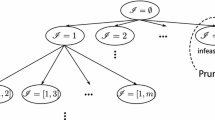Abstract
The constraint programming community has recently begun to address certain types of optimization problems. These problems tend to be discrete or to have discrete elements. Although sensitivity analysis is well developed for continuous problems, progress in this area for discrete problems has been limited. This paper proposes a general approach to sensitivity analysis that applies to both continuous and discrete problems. In the continuous case, particularly in linear programming, sensitivity analysis can be obtained by solving a dual problem. One way to broaden this result is to generalize the classical idea of a dual to that of an “inference dual,” which can be defined for any optimization problem. To solve the inference dual is to obtain a proof of the optimal value of the problem. Sensitivity analysis can be interpreted as an analysis of the role of each constraint in this proof. This paper shows that traditional sensitivity analysis for linear programming is a special case of this approach. It also illustrates how the approach can work out in a discrete problem by applying it to 0-1 linear programming (linear pseudo-boolean optimization).
Similar content being viewed by others
References
Barth, P. (1995). Logic-Based 0-1 Constraint Solving in Constraint Logic Programming, Kluwer, Dordrecht.
Chvátal, V. (1983). Linear Programming, W. H. Freeman, New York.
Cooper, M. C. (1989). An optimal k-consistency algorithm, Artificial Intelligence 41: 89-95.
Hooker, J. N. (1988). A quantitative approach to logical inference, Decision Support Systems 4: 45-69.
Hooker, J. N. (1992). Generalized resolution for 0-1 linear inequalities, Annals of Mathematics and Artificial Intelligence 6: 271-286.
Hooker, J. N. (1994). Logic-based methods for optimization, in A. Borning, ed., Principles and Practice of Constraint Programming, Lecture Notes in Computer Science 874: 336-349.
Hooker, J. N. (1996). Logic-based Benders decomposition. Available on http://www.gsia.cmu.edu/afs/andrew/afs/jh38/jnh.html.
Nemhauser, G. L., and L. A. Wolsey (1988). Integer and Combinatorial Optimization, Wiley, New York.
Quine, W. V. (1952). The problem of simplifying truth functions, American Mathematical Monthly 59: 521-531.
Quine, W. V. (1955). A way to simplify truth functions, American Mathematical Monthly 62: 627-631.
Robinson, J. A. (1965). A machine-oriented logic based on the resolution principle, Journal of the ACM 12: 23-41.
Schrage, L., and L. Wolsey (1985). Sensitivity analysis for branch and bound integer programming, Operations Research 33: 1008-1023.
Schrijver, A., (1986). Theory of Linear and Integer Programming, Wiley, Chichester.
Skorin-Kapov, J., and F. Granot (1987). Nonlinear integer programming: Sensitivity analysis for branch and bound, Operations Research Letters 6: 269-274.
Author information
Authors and Affiliations
Rights and permissions
About this article
Cite this article
Hooker, J.N. Inference Duality as a Basis for Sensitivity Analysis. Constraints 4, 101–112 (1999). https://doi.org/10.1023/A:1009838725226
Issue Date:
DOI: https://doi.org/10.1023/A:1009838725226




